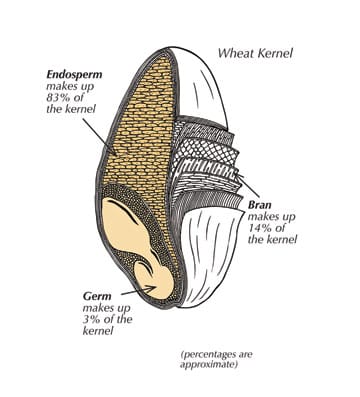Everywhere you look, products are advertised as being made from whole grains. Why all the fuss? Studies have shown that whole grains are helpful in reducing the risk of some types of cancer. As well, the phytochemicals and antioxidants in whole grains help fight heart disease by decreasing cholesterol levels and blood pressure. Whole grains contain more fiber than refined grains, which slows the absorption of sugar and helps regulate blood glucose levels. And if that's not enough, the complex carboyhdrates in whole grains make you feel full, which lowers the risk of obesity and helps with weight loss.
Whole grains are the whole seeds of such plants as oats, barley, corn, wheat, rye, millet, and quinoa. They have three parts: the bran; the endosperm or internal seed, which is the largest part of the grain; and the germ. The bran contains B vitamins, minerals, and most of the seed's fiber. The endosperm is full of complex carbohydrates and smaller amounts of B vitamins and protein. The germ is a concentrated source of vitamins and minerals. Refined grains like white flour or white pasta contain only the endosperm, making them less nutritious choices than whole-grain flours and pasta. Check product ingredient lists to determine whether a product has whole grains. Look for the word "whole" in front of the grain, as in whole oats, whole barley or whole corn. It's a good idea to choose foods with whole grains listed in the first few ingredients. If they are listed later on, they may not have enough whole grains to be of much benefit.

"Whole wheat" does not always mean 100% whole grain. When flour is milled, manufacturers can remove up to 5% of the entire kernel to improve the product's shelf life. However, even though the flour cannot be called 100% whole grain, it's still healthier than white flour. Look for "whole grain, whole wheat" in the ingredient list or 100% whole grain on the package to make sure you are getting a whole grain, whole wheat product.
Some other things to keep in mind when looking for whole grains: multigrain products may not be made from whole grain. They could be made with some refined grains; there are no legislative guidelines in this regard. Organic foods are not always whole grain. They could be made with organic refined grains. Stone ground is a term that describes how the grain is milled; the grain may not be whole. Bread that is brown does not always mean whole grain: the rich, dark colour might come from molasses or caramel.
Whole grain products aren't necessarily healthy. Some whole grain choices are also high in sugar, fat and salt, which makes them less healthy choices. Use the Nutrition Facts table to help you decide if your whole grain choice is a healthy one.
 Reasons to eat whole grains
Reasons to eat whole grains
- Keeps digestive system healthy
- Helps control blood pressure, cholesterol and weight
- Moderates blood sugar levels
- Reduces risk of heart disease and some cancers
Canada's Food Guide encourages people to make at least half of daily grain products whole grain, which means at least three servings each day for adults.
Making Room for Whole Grains
- Make a sandwich with rye or oat meal bread.
- Cook with brown or wild rice instead of white rice.
- Use millet instead of couscous in recipes.
- Add brown rice, wild rice or whole barley to homemade soups.
- Start the day with whole-grain cereal or oatmeal.
- Use oatmeal or whole-grain flour (e.g., buckwheat or brown-rice flour) in baking.
- Use oatmeal or cooked bulgur in hamburger patties or meatloaf.
- Snack on popcorn.
- Have corn as part of your meal.
- Eat quinoa as a grain or use in salads, chili or stews.
Using Whole Grains on their Own
Cooking most whole grains is very similar to cooking rice. Rinse them under cold water before using. Put them in a pan with water or reduced sodium broth. Bring to a boil, cover and simmer until the liquid is absorbed. Bulgur is not prepared the same way; it is soaked in water until tender.
See directions on each package (varies with each grain). If the grain is not as tender as you like when "time is up," add more water and continue cooking.
Recipe featured in this article:
Jennifer Ferguson is a Sobeys Professional Dietitian in Truro, NS
